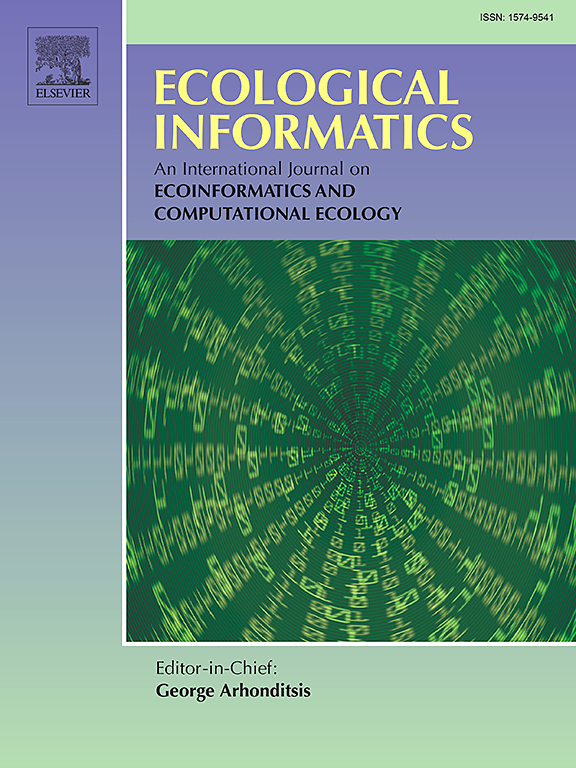Adapting a global plant identification model to detect invasive alien plant species in high-resolution road side images
IF 5.8
2区 环境科学与生态学
Q1 ECOLOGY
引用次数: 0
Abstract
Early detection of invasive alien plant species is crucial for addressing their environmental impact. Recent advancements in vehicle-mounted equipment enable automatic analysis of high-resolution images to detect invasive plants along roadsides, a primary vector for their spread. Deep learning technologies show promise for processing this data efficiently, but the choice of approach significantly affects both computational and human resource costs. Object detection and segmentation methods require costly annotations, making them impractical for scaling to the thousands of invasive species worldwide. In contrast, multi-label classification, i.e. to predict all species present in the image, is less demanding but still challenging to implement without many annotated images for numerous species. However, large datasets from citizen science platforms such as Pl@ntNet or iNaturalist offer rich visual data for classifying individual plant species. In this article, we assess whether large plant identification models trained on such data can be leveraged for species detection in high-resolution images. Specifically, we explore two approaches: a multi-label classification model and a tiling-based model, using a vision transformer from the Pl@ntNet platform. We evaluate these models on high-resolution roadside images, both using a pre-trained model without fine-tuning and after applying fine-tuning. Our findings indicate that the tiling approach significantly outperforms other methods without fine-tuning and shows a slight advantage when fine-tuning is applied, demonstrating significant potential for detecting thousands of species without task-specific adaptation.
基于全局植物识别模型的高分辨率路边影像外来入侵植物识别
早期发现外来入侵植物物种对解决其环境影响至关重要。车载设备的最新进展使高分辨率图像自动分析能够检测路边入侵植物,这是它们传播的主要媒介。深度学习技术有望有效地处理这些数据,但方法的选择会显著影响计算和人力资源成本。目标检测和分割方法需要昂贵的注释,这使得它们无法扩展到全球数千种入侵物种。相比之下,多标签分类,即预测图像中存在的所有物种,要求较低,但在没有大量物种的注释图像的情况下实现仍然具有挑战性。然而,来自公民科学平台(如Pl@ntNet或iNaturalist)的大型数据集为分类单个植物物种提供了丰富的视觉数据。在本文中,我们评估了在这些数据上训练的大型植物识别模型是否可以用于高分辨率图像中的物种检测。具体来说,我们探索了两种方法:多标签分类模型和基于贴片的模型,使用Pl@ntNet平台的视觉转换器。我们在高分辨率路边图像上对这些模型进行了评估,既使用了未进行微调的预训练模型,也使用了经过微调的模型。我们的研究结果表明,平铺方法在没有微调的情况下明显优于其他方法,并且在应用微调时显示出轻微的优势,这表明了在没有特定任务适应的情况下检测数千种物种的巨大潜力。
本文章由计算机程序翻译,如有差异,请以英文原文为准。
求助全文
约1分钟内获得全文
求助全文
来源期刊

Ecological Informatics
环境科学-生态学
CiteScore
8.30
自引率
11.80%
发文量
346
审稿时长
46 days
期刊介绍:
The journal Ecological Informatics is devoted to the publication of high quality, peer-reviewed articles on all aspects of computational ecology, data science and biogeography. The scope of the journal takes into account the data-intensive nature of ecology, the growing capacity of information technology to access, harness and leverage complex data as well as the critical need for informing sustainable management in view of global environmental and climate change.
The nature of the journal is interdisciplinary at the crossover between ecology and informatics. It focuses on novel concepts and techniques for image- and genome-based monitoring and interpretation, sensor- and multimedia-based data acquisition, internet-based data archiving and sharing, data assimilation, modelling and prediction of ecological data.
 求助内容:
求助内容: 应助结果提醒方式:
应助结果提醒方式:


